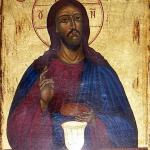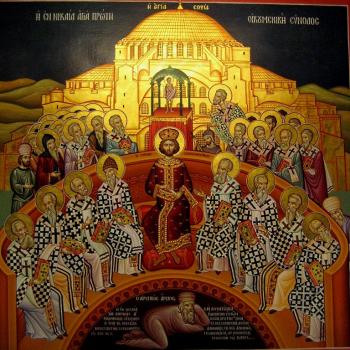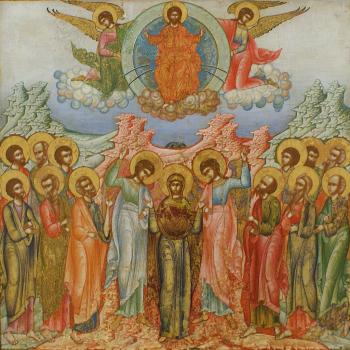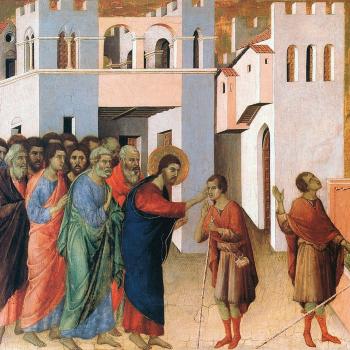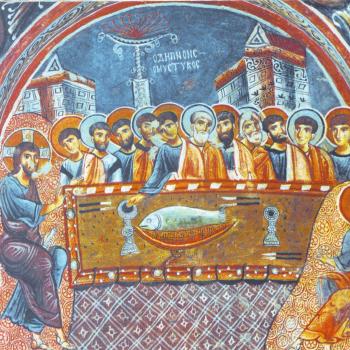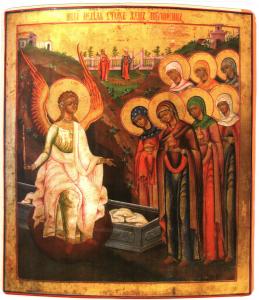
The second Sunday of Eastertide in the Byzantine tradition is the Sunday of the Myrrh-Bearing Women. On it, this Eastern tradition commemorates the remarkable witness of the women who followed Christ. In many ways, their story shows us something which is proven true throughout history: the women who followed Jesus were braver and more devout than their male counterparts, and yet their voice, their fidelity was often ignored. The myrrh bearing women were the women who followed after Christ, who stood watch over Christ, even unto his death, while most of the men took flight, thinking their hopes and dreams had been squashed.
There are several women who are accounted for as among the myrrh bearing women, including: Sts. Mary Magdalene, Salome, Susanna, Joanna, Mary and Martha of Bethany (the sisters of Lazarus), Mary the Mother of James, and Mary the wife of Cleopas. With them, to be sure, we find Sts. Joseph of Arimathea, Nicodemus, and the Theotokos, Mary the Mother of God, so that among the myrrh bearers were some of the disciples who desired to honor Jesus.
Nonetheless, just as there was a central contingent of Jesus’s male disciples, we find there was a group of women who consistently followed after Jesus, who were often seen not only with Jesus, but his mother, and unlike his core male disciples, they kept a sense of fidelity to Christ which made them want to honor and protect him even in death. Although they often worked together, they also divided amongst themselves various different activities.
In the Gospel records, we find various different listings of who went to Jesus’ tomb; what is accepted by them all is that St. Mary Magdalene had a special place among them as she was the first told to serve as a witness to the resurrected Christ:
There were also women looking on from afar, among whom were Mary Magdalene, and Mary the mother of James the younger and of Joses, and Salome, who, when he was in Galilee, followed him, and ministered to him; and also many other women who came up with him to Jerusalem (Mk. 15:40-41 RSV).
Now it was Mary Magdalene and Joanna and Mary the mother of James and the other women with them who told this to the apostles; but these words seemed to them an idle tale, and they did not believe them. But Peter rose and ran to the tomb; stooping and looking in, he saw the linen cloths by themselves; and he went home wondering at what had happened (Lk. 24:10-12 RSV).
Now when he rose early on the first day of the week, he appeared first to Mary Magdalene, from whom he had cast out seven demons. She went and told those who had been with him, as they mourned and wept. But when they heard that he was alive and had been seen by her, they would not believe it (Mk. 16:9-11 RSV).
It is often asked why the discrepancy between the texts, that is, why do they seem to list different women going to Jesus’s tomb? The answer, as St. Gregory Palamas explained, is that the myrrh bearing women came to Christ’s tomb, hoping to anoint Christ’s body, at different times. St. Mary Magdalene, among the myrrh bearers, was the first to see the empty tomb, but she did not meet the resurrected Christ until later, showing that she came to the tomb several times herself, possibly with different women each time:
The evangelists seem to a certain extent to disagree about what time it was and how many women were there. This Is because, as we have said, there were many myrrhbearers and they did not come just once to the tomb, but two or three times. They came in groups, but not always the same women. They all came at dawn, but not precisely the same time, and Mary Magdalen came once more on her own and stayed longer. [1]
We can see this in the various narratives of the Gospels. Mary, for example, is said to have first seen the empty tomb, rushed to tell Peter and John, and then came back:
Now on the first day of the week Mary Magdalene came to the tomb early, while it was still dark, and saw that the stone had been taken away from the tomb. So she ran, and went to Simon Peter and the other disciple, the one whom Jesus loved, and said to them, ‘They have taken the Lord out of the tomb, and we do not know where they have laid him.’ (Jn. 20:1-2 RSV).
The reason why the myrrh bearing women went to Christ’s tomb was that they wanted to anoint his body, to bless it; they would have done so earlier, except that the time of his death made this impossible. They had to wait until after the Sabbath, as St. Anthony of Padua commented:
The Gloss on Matthew says that the commandment was to observe the Sabbath rest from evening to evening; and so the religious women, after the Lord’s burial, occupied themselves in preparing ointments as long as it was lawful to work – that is, until sunset on Good Friday. And because, due to lack of time, they could not complete their task, as soon as the Sabbath was over (that is, after sunset) and it was possible to work again, they hastened to buy spices, so that in the morning they might come and anoint the body of Jesus.[2]
Because they were not free to anoint his body until Sunday, they came and went from the tomb; only Mary the Theotokos is said to have stayed throughout the time, and it is for this reason, it is said that she actually saw the resurrection taking place, as St. Maximos the Confessor recorded in his life of Mary:
Nevertheless, the immaculate mother was inseparable from the tomb, and she was watching and listening to everything that was happening and being said. She saw the great earthquake that woke the first fruits of those who have fallen asleep (cf. 1. Cor 15.20) and put the guards to sleep and rolled away the stone (cf. Matt. 28.2, 4), and then the waking of the guards again and their entry into the city (cf. Matt. 28.11). All this the women who had gone and come back again were not able to see, but the blessed mother of the Lord, seized by love of her son and standing inseparably at the tomb, was a witness to everything until she saw even his glorious Resurrection. For the other women saw the stone rolled away and the angel sitting on it; but when and how this took place, they did not know this at all. Only the immaculate mother of the Lord standing there knew everything.[3]
St. Anthony of Padua, of course, agreed:
But blessed Mary, after the Lord her Son had been buried, never departed (some say) from the tomb, but continually kept watch there, weeping until she was the first to be found worthy to see him risen; and so in her honour Saturday is celebrated by the faithful.[4]
Mary, the Theotokos, was the first to know of the resurrection, but she was not asked to spread the message of the resurrection. It would have caused suspicion if she had been the first to proclaim it. “That’s just what his mother would say.” Rather, others would have to witness what happened after the resurrection, to witness the empty tomb and the resurrected Christ. St. Mary Magdalene was the first of those witnesses, the first called to preach the message of the resurrection to others. It was a woman who saw the resurrection, and it was a woman who was the first to proclaim it to the rest of Jesus’ disciples. It was the women who had not fled. It was mostly the women who continued their devotion even after Jesus’ death. Many have noted this as very fitting: through women the glory of the resurrection, the preaching of ever-lasting life comes, showing that women are not to be thought of as cursed because of the story of Eve, but rather as bearers of life. For this reason, they bore the message of the triumph of life, giving birth to the first Easter proclamation:
Verily, the angel came to the tomb and said to the ointment-bearing women, the ointment is meet for the dead, but Christ is shown to be remote from corruption. But cry ye, ‘The Lord is risen, granting the world the Great Mercy.’ (Troparion of the Sunday of the Myrrh Bearing Women).
The women bearing ointments to anoint Christ were granted a vision, where they saw what lay beyond the kingdom of death, which is the everlasting glory of the light of the life of the world. Death has an end. The kingdom of God overcomes death granting life to all. Enlightened by the glory of the resurrection, the myrrh bearing women preached the good news, with St. Mary Magdalene leading them as “the Apostle to the Apostles.” Mary Magdalene was sent out to preach, she who bore such great love for Jesus she found the fruit of that love being the glory of the resurrection itself, transforming her and her mission as a result of it. The faith, as St. Hildegard taught, was spread because of these illustrious women:
Two different feeling occupied the minds of the women: fear and joy. The former came from the greatness of the miracle, the latter from their longing for the Resurrected One. And yet both feelings quickened their feminine steps. They went to the apostles so that through them the seedbed of faith would be scattered.[5]
The Theotokos, the myrrh bearing women, then Peter and John, were the first witnesses of the resurrection. The Theotokos had the special gift of witnessing the resurrection as it happened, with the myrrh bearing women, because of their great love and devotion, were the first to see what happened after the resurrection and the first called to spread the word to Jesus’ followers that he had risen. If we want to properly remember them, if we remember their extraordinary witness, should we not consider what remarkable glory he can share to us through his eminent and holy women disciples today?
[1] St. Gregory Palamas, “On the Sunday of the Myrrhbearers” in Saint Gregory Palamas: The Homilies. Trans. Christopher Veniamin (Waymart, PA: Mount Thabor Publishing, 2009),146-7.
[2] Saint Anthony of Padua, Sermons for Sundays and Festivals. Volume I. trans. Paul Spilsbury (Padua: Edizionio Messaggero Padova, 2007), 234.
[3] St. Maximus the Confessor, The Life of the Virgin. Trans. Stephen J. Shoemaker (New Haven: Yale University Press, 2012), 119.
[4] Saint Anthony of Padua, Sermons for Sundays and Festivals. Volume I, 234.
[5] St. Jerome, Commentary on Matthew. Trans. Thomas P. Scheck (Washington, DC: CUA Press, 2008), 325.
Stay in touch! Like A Little Bit of Nothing on Facebook.
If you have liked what you read, please consider sharing it with your friends and family!



